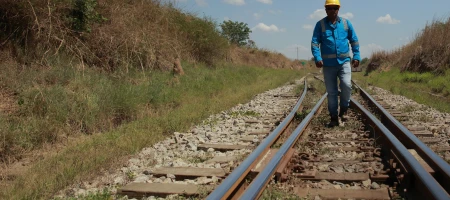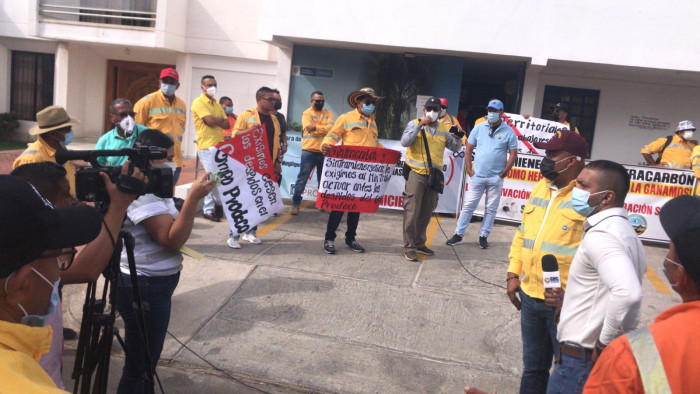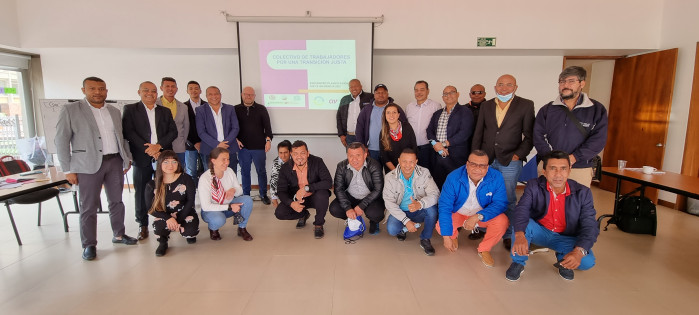
A call for current actors in the coal chain to assume responsibility
The Colombian government is currently trying to diversify its energy matrix and to undertake international commitments in the face of climate change. However, due to several changes in the coal mining sector in northern Colombia, a shift of its actors is taking place. To respond to the impact of current developments on miners, the Workers’ Collective was created. They are calling for a just transition which addresses the transformations that the sector is undergoing without leaving anyone behind.
In Colombia, the energy transition is part of the current political discourse. However, given the effects this transition has on the workers and communities of the coal corridors in the north of the country, it is clear that this is anything but a just and fair transition.
Great concerns among workers and communities
Following the hearings of the temporary commission of the Colombian congress to study the future of coal in Northern Colombia, the various grievances of workers and communities because of mine closures and mass layoffs in northern Colombia have become clear. Thus, while the national government celebrates the energy transition as a step forward for the country, there is great concern among workers and communities about the lack of both a transition process and a fair approach to decarbonization that leaves no one behind.

Prodeco | Glencore returns mining title in the midst of the pandemic
Over the last two years, coal mining in northern Colombia has undergone a number of changes due to strategic decisions made by some coal companies.
Prodeco, a subsidiary of Glencore in Colombia, announced that they would return mining titles and cease operations at the Calenturitas and La Jagua mines in the middle of the pandemic crisis. This announcement created a lot of commotion through northern Colombia, but it also forced a plan for an abrupt closure of the mine, accompanied by massive layoffs, which has affected more than 5,000 employees. Moreover, the coal company Carbones del Cerrejón also initiated a process of workforce reduction in La Guajira that has led to discontent among the workers.
These measures by Glencore were attributed to the fall in coal prices in 2020. Nevertheless, this year Glencore became the owner of Carbones del Cerrejón, which operates in the department of La Guajira. The closure of the mines in Cesar alongside an increasing interest in the mines of La Guajira, was therefore interpreted by some stakeholders as a strategy by Glencore to relocate without fulfilling its corporate responsibility to its workers, the affected communities and the environment. Glencore, however, reasoned it to be a desperate measure in the face of a possible coal crisis in the context of the energy transition.
As some coal workers’ representatives highlighted during the the temporary commission of the Colombian congress hearing in Cesar, these actions can be interpreted as a set of tactics. For example, the mass dismissal of workers has been accompanied by the creation of new outsourcing contracts in other areas of work.
New actors in the energy sector in Northern Colombia
In recent years, renewable energy generation projects have been on the rise. A driving factor has been the implementation of the energy transition law, in which the national government outlined its objective to diversify Colombia’s energy matrix and contribute to fight climate change. Its goal is to increase the share of non-conventional renewable energy sources to 2,400 megawatts (12%) by the end of 2022. For this reason, new energy investors have settled in the north of the country.
Sun and wind
Clean energy generation projects have focused their interest on the production potential of northern Colombia. In places like La Guajira, the solar radiation is 60% higher and the wind speed in the region is twice as fast as the world average. Therefore, projects with a capacity of 1,373 megawatts were allocated in La Guajira.
Hydrogen
One of the government's plans to diversify its energy matrix is its strategy is to exploit coal deposits and use them in a complementary way for the production of blue hydrogen. Although this strategy is not yet being implemented, its implementation would necessarily involve the coal corridors of northern Colombia.
Diversification of the energy matrix
Despite the progress in integrating clean energy, the diversification of Colombia’s energy matrix is still in its infancy, especially since the country is still dependent on coal. Hence, the process being carried out by the Colombian government seems more like an addition of new energy sources to the country's energy matrix instead of as a transition. Especially considering the absence of an effective implementation of a plan to reduce carbon. Nevertheless, the Ministry of Mines and Energy has committed to reduce carbon dioxide emissions by 11.2 million tons by 2030.
The introduction of new energy actors in northern Colombia could be an opportunity to expand the productive alternatives in the region from a sustainable development vision. However, the communities and workers have already expressed their concern that clean energy projects will reproduce an enclave economy and will not bring about significant change in the welfare of the population.
How coal has arrived in northern Colombia
Coal mining was introduced to northern Colombia about four decades ago as an enclave economy that displaced other existing productive sectors in the region, such as traditional agriculture. In addition to the incomes and jobs generated after its implantation in the north of the country, this economy is characterized by the support of other sectors, such as tourism and transport, among others.
Territories sacrificed for mining under the pretext of energy security
However, according to Amarilys Llanos, representative of the Colombian Congressional Accidental Committee, mining is not a relevant development proposal for the region because poverty is higher there than in other areas where mining is not practised. Llanos asserts that Cesar and La Guajira are territories sacrificed for mining under the pretext of energy security. This is mainly due to the fact that the north of Colombia has had to submit to land use planning in favour of mining, which has led to the diversion of aquifers, the loss of agricultural activities and the subjection of communities to resettlement processes. It has also let to social, economic, environmental and health problems.
In addition, there is a historical link between the armed conflict and mining activity on Colombian territory. Due to dynamics such as displacement and land expropriation by illegal armed groups, some multinational mining companies have indirectly benefited from the acquisition of these lands for the exploitation of coal.
The violation of labour rights of miners is also a recurring problem. However, in the current context of closure and mass redundancies, the workers’ group is one of the most affected actors.
The four axes of the Workers Collective
Faced with the current situation in the coal sector in the north of the country, the workers decided to demand a just transition as a measure to address the changes the sector is undergoing without leaving anyone behind. For this reason, the Workers’ Collective for a Just Transition was created, of which coal mine trade unions Sintracarbón, Sintracerrejón, Sintradem, Sintramienergética and Sintradrummond are members. They collectively work towards integrating the voices of the workers and the communities involved to build an energy transition process that is fair and inclusive.

The Collective’s four areas of work are:
- union training preparation,
- social protection,
- economic diversification and
- labour restructuring.
In collaboration with CNV Internationaal, it seeks to be a partner in dialogue to minimize the negative impact and safeguard the rights of workers and their families, in addition to requesting space for dialogue with the national government, with companies and with other international organizations, so that the coal mining industry and the Colombian authorities assume their responsibility and allow for a just transition.
Far from just
Taking into accountthe Stockholm Environment Institute’s Principles for a Just Transition, the process of decarbonization is far from having started because of the country's dependence on this economy, which is still visible in its energy transition plans, and because of actions such as those of Glencore to acquire more shares in Cerrejón. Currently, a just transition is far from being within reach.
Efforts to create space for dialogue
Furthermore, the actions of the Colombian government to support the regions and actors affected by the closure of mines have been limited. Although it has highlighted the perspective of communities in its reports on energy transition, they still do not feel heard. For this reason, initiatives such as the Workers' Collective for a Just Transition have been created. The creation of the Colombian Congressional Accidental Committee and its attempts to create a space for dialogue through hearings in order to solve the problems posed by coal mining in northern Colombia are worthy of mention, although it remains to be seen whether these attempts will lead to real change.
Damage from the past too
On the other hand, since the region’s major problems of environmental, social and economic damage are not recent, it can be argued that both the Colombian government and the companies have not effectively addressed these conflicts, so that until they are really addressed there cannot be a just transition in the country.
Experiences from The Netherlands and Spain
The experiences from The Netherlands and Spain can serve as clear examples for Colombia to assume a just transition as an energy transition commitment that meets the decarbonization objectives and commits to climate change from social and environmental responsibility. As reflected in these two countries, in order for a just transition to be consolidated, it is necessary to build and agree on transition plans with workers, communities, companies and the government.
A call for the national government and international actors in the coal chain
Due to the many problems in northern Colombia because of the changes that have taken place in recent years, it is important that the Colombian government and the international actors involved in the coal value chain adopt a realistic vision of just transition, which is articulated by the workers, their organizations, and the affected communities.
As other experiences with just transitions reflect, dialogue and inclusion of workers and communities in energy transition decision making is essential. If they are included, during the decarbonization and diversification of the energy matrix, no one is left behind.
Publication date 17 02 2022



